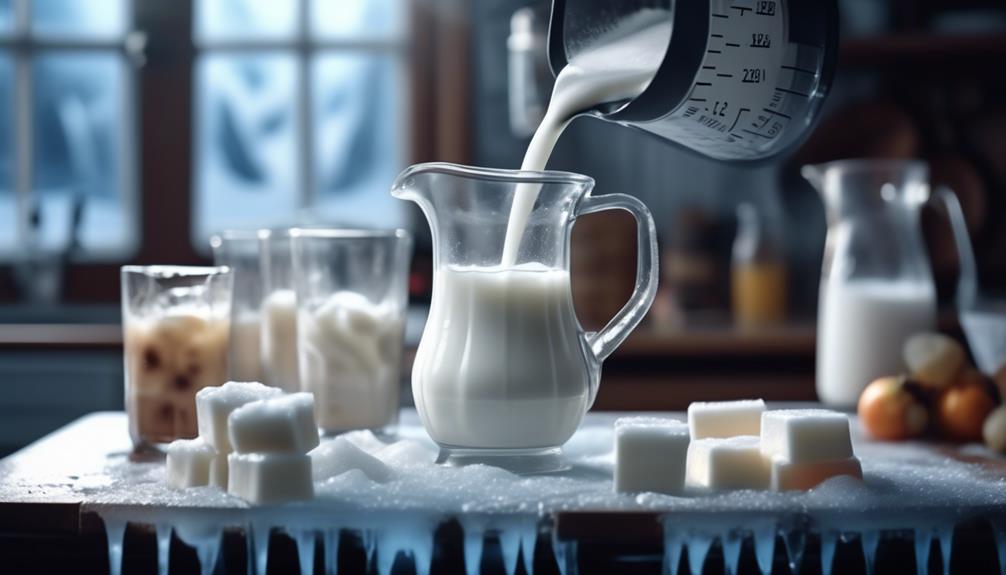Despite what you might think, freezing milk is a practical way to extend its shelf life without significantly altering its taste or nutritional value.
You'll want to start by choosing the right container—preferably one that's airtight and leaves enough room for the milk to expand as it freezes.
It's essential to understand that while most milk can be frozen, the process works best with whole and skim varieties.
You're going to need to pour the milk into your selected container, taking care not to fill it to the brim, and then seal it tightly before placing it in the freezer.
If you follow the correct steps, you'll be able to thaw it later with minimal changes to texture and flavor.
But before you place that container in the freezer, there are nuances to this process that can mean the difference between a just-okay outcome and achieving the best possible results when you bring your milk back to its liquid state.
Key Takeaways
- Choose a durable and expandable container, such as plastic containers or freezer-safe bags
- Ensure the container is food-grade and BPA-free to avoid health risks
- Leave about an inch of space at the top of the container to accommodate milk expansion
- Label the container with the freezing date for tracking and using within a reasonable time frame
Selecting the Right Container
When freezing milk, choosing a container that's both durable and leaves room for expansion is crucial to maintain quality. You'll want to select a container that can withstand the low temperatures without cracking or breaking. Glass, although safe for freezing, may not be the best choice due to its tendency to break. Instead, you're better off using plastic containers or bags specifically designed for freezing.
Container durability isn't just about surviving the freezer. It's also about ensuring that your milk thaws without any leakage or contamination. Make sure you're using containers that aren't only freezer-safe but also food-grade to guarantee material safety. BPA-free plastic is essential, as BPA can leach into your milk and pose health risks.
When pouring milk into your chosen container, leave about an inch of space at the top. This gap allows the milk to expand as it freezes, preventing the container from bursting. Secure the lid tightly or seal the bag properly to prevent any air from getting in, which can cause freezer burn and affect the milk's flavor.
With these careful steps, you'll preserve the freshness and safety of your milk for future use.
Preparing Milk for Freezing
Having selected a suitable container, it's time to focus on the proper steps to prepare your milk for the freezing process. You'll want to ensure that the milk is prepped correctly to maintain its quality and safety upon thawing. Here's how you can do that:
- Leave Space for Expansion
- Milk expands when frozen, so leave about an inch of space at the top of the container to accommodate this.
- If you're using the original milk carton, pour out a small amount to prevent it from bursting.
- Practice Good Sanitation
- Wash your hands thoroughly before handling the milk and any containers.
- Ensure containers are cleaned with hot, soapy water and dried completely to prevent contamination.
- Temperature Considerations
- Cool the milk in the refrigerator before transferring it to the freezer. This helps with milk expansion and reduces the risk of the container cracking.
- Freeze milk early in its shelf life to retain the best quality post-thaw.
Freezing Process Steps
Before placing your milk in the freezer, ensure it's at the optimal temperature by chilling it in the refrigerator first. This step is crucial because a gradual decrease in temperature helps maintain the milk's quality. Once chilled, move on to the freezing process, mindful of milk expansion during freezing.
Choose a container with enough headspace to allow for the milk to expand. A good rule of thumb is to leave about an inch of space at the top of the container. If you're using the original plastic jug or carton, pour out a small amount to prevent the container from bursting as the milk expands.
Seal the container tightly to keep out air and prevent freezer burn. It's also important to avoid any contaminants from entering and affecting the milk's flavor.
Labeling date on the container is a step you shouldn't skip. Use a marker to write the current date on the container. This helps you track how long the milk has been frozen and ensures you use it within a reasonable time frame—typically within a month for best quality.
Now, place the container in the coldest part of your freezer, usually at the back, away from the door. This spot experiences the least temperature fluctuations, keeping your milk frozen solid until you're ready to thaw and use it.
Thawing Frozen Milk
To properly thaw frozen milk, transfer it from the freezer to the refrigerator, allowing it to slowly defrost while maintaining a safe temperature. This gradual process helps preserve the milk's consistency, which can be altered by temperature changes. Expect it to take about 24 hours for a gallon of milk to completely thaw.
Here's a detailed guide on managing the thawing process:
- Monitor the Milk
- Check periodically for consistency.
- Gently shake the container once partially thawed to mix separated components.
- Speeding Up Thawing
- Place the milk in a bowl of cold water if you're in a hurry, changing the water every 30 minutes.
- *Never* use hot water or a microwave, as this can damage the milk's structure and quality.
- Post-Thaw Usage
- Inspect the milk for any off odors or discoloration before using.
- Stir or shake well before each use to ensure uniformity.
Remember that after thawing, the milk's consistency mightn't be perfect for drinking, but it's still suitable for various usage ideas. Consider using thawed milk for cooking, baking, or making smoothies where texture differences are less noticeable. Always use thawed milk within a few days to ensure freshness and quality.
Tips for Best Results
After understanding how to thaw frozen milk, let's explore how to achieve the best results when freezing milk to ensure its quality and extend its shelf life. First, you'll want to use fresh milk; the fresher it is, the better it'll freeze and later taste. If you're storing milk for several months, its shelf life is your priority, and freezing can effectively extend it.
Pour the milk into an airtight container, but don't fill it to the brim. Leave about an inch of space to allow for expansion as the milk freezes; this prevents the container from cracking or bursting. Use plastic bottles or freezer-safe glass jars specifically designed to handle the expansion of liquids when frozen.
To prevent taste alteration, make sure the container is sealed tightly. This helps to protect the milk from absorbing odors or flavors from other foods in the freezer. It's also wise to label the container with the date of freezing, so you can use the oldest ones first and avoid waste.
Lastly, when you're ready to use the milk, thaw it in the refrigerator slowly. This gradual process helps maintain the milk's texture and flavor, providing you with a product that's as close to fresh as possible after freezing.

